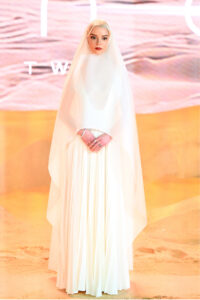GRAPHIC DESIGN Mia Yaguchi-Chow
“After a year of often sitting on Zoom calls without being fully dressed or while wearing the same dirty jeans and tee shirt, I am ready to put on a suit” says Tom Ford, one of the last standing defenders of the suit—or is he? Both Canada and the United States continue opening back up, and post-pandemic dressing is taking shape as the industry plans for the next era of menswear.
As far back as April 2020, GQ’s Cam Wolf insisted that dressing up after the pandemic was all but an inevitability; #menswear 2.0 would move away with the maximalism of the mid-to-late 2010’s and instead towards a new, more personable minimalism. It was a loud and proud testament to the power of dressing with intention.
“Getting dressed up might feel like an urgent necessity,” wrote Wolf, “it’ll be a symbol of hope too.”
With the well-documented rise of athleisure came the predicted death of not just the suit, but of blazers themselves—the gold standard for men’s business and business casual dressing. Hypermasculine JFK-esque suits, however, haven’t reflected the state of modern menswear for years. What Armani power suits and Tod’s loafers were to the ‘80s, Patagonia vests and Everlane chinos were to the 2010s; suiting, no longer a job requirement, is almost exclusively a fashion-first choice.
The next phase of business casual will still rely on intentional dressing, while still accounting for the comfort we’ve gotten used to over a year into work-from-home. The Lyst Index, a quarterly ranking of the most popular brands and products based on worldwide searches declared the passing of “peak sweatpant” in the first quarter of 2021; this is a new kind of in-between dressing, signified by the ranking of a button-down denim shirt from luxe Italian countryside brand Brunello Cucinelli on their ten most popular men’s products for Q1.
Over at the Wall Street Journal, Jacob Gallahager noted the “present-meets-future mix” of relaxed dressing outside the home for FW 2021—think soft, earth-tone sports blazers and wide-legged trousers at Ermenegildo Zegna, or knitted, comfort-first polos at Jil Sander. From even before the pandemic, fashion came to the realization that it really can’t afford to keep traditional tailoring and sweatpants-level comfort as mutually exclusive. If contemporary labels like Reiss or Sandro are any indication, there’s no reason why tailored pants can’t have elastic waistbands to ease customers out of worn-in sweatsuits.
As one Mashable writer put it, “my favorite thing about the Comfort Revolution is you can look like you care while also looking like you care about comfort.”
The “Comfort Revolution” doesn’t plan on sacrificing style. Instead of joggers and Hawaiian shirts, look to Instagram where Italy’s if-you-know-you-know brand Canali announced the arrival of the Shacket, “a garment that feels free like a shirt and fine like a jacket.”
In other words, blazers are far from dead and business casual is only going to get more comfortable from here on out.
If looking to the past for a reference point, 2008’s Great Recession was the last big disrupter in the fashion industry, and with it came a class of designers like Phoebe Philo and Alessandro Michele; the new uniform will look like something in between tasteful restraint at Daniel Lee’s Bottega Veneta, and Raf/Miuccia’s organized chaos at Prada. The pre-pandemic, anything-goes era of menswear will continue—just a little less rough around the edges.
“Dressing up” may not be the exact word for it, but experimental, deconstructed suiting and pleated, elastic waistband trousers embodies the hybrid future of menswear. The post-pandemic workplace, whatever that may look like, will welcome this radical triumvirate of comfort, put togetherness, and individuality.
























